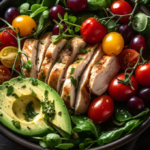Medically Reviewed by Lucas Rosa, PhD in Molecular Biology
When you hug someone you love, cuddle a pet, or share a good laugh with friends, you’re not just enjoying the moment, your brain is also releasing oxytocin.
Oxytocin plays a powerful role in building relationships, lowering stress, and promoting emotional well-being.
In this blog, we’ll explore what oxytocin is, how it works, where it’s made, and the best natural ways to keep your oxytocin levels in balance for a healthier, happier life.
What Is Oxytocin?
Oxytocin is a hormone and neurotransmitter that acts as a chemical messenger in the brain and body. It’s often called the “love hormone” and best known for promoting feelings of bonding, trust, love, empathy, and connection.
But oxytocin isn’t just about romantic relationships, it also helps strengthen friendships, family ties, and even how you relate to pets and your wider community.
What Does Oxytocin Do?
Oxytocin influences both emotional and physical processes. Some of its key roles include:
- Bonding and Trust: Promotes closeness between partners, parents and children, and even between friends.
- Stress Reduction: Lowers cortisol (the stress hormone) and calms your nervous system.
- Improving Social Skills: Encourages eye contact, empathy, and emotional awareness.
- Wound Healing: Studies suggest it may help reduce inflammation and speed up recovery.
- Reproduction and Childbirth:
- Stimulates uterine contractions during labor
- Helps release breast milk during breastfeeding
- Encourages maternal bonding
- Sexual Arousal and Intimacy: Often released during physical affection and sexual activity, enhancing emotional connection.
Oxytocin is sometimes nicknamed the “cuddle chemical” because of its link to touch and warmth, but its reach goes far beyond cuddles.

Where Is Oxytocin Made?
Oxytocin is made in the hypothalamus, a small but powerful region at the base of the brain. It’s then stored and released by the posterior pituitary gland into the bloodstream and also sent to various parts of the brain.
Its release is triggered by both physical and emotional stimuli like eye contact, hugging, listening to soothing music, or meaningful conversations.
Signs of Low Oxytocin
If oxytocin levels are too low, you might notice:
- Feeling Emotionally Distant or Disconnected
- Trouble Trusting Others
- Social Anxiety or Withdrawal
- Increased Stress or Irritability
- Difficulty Bonding with loved ones
- Poor Empathy or Compassion
These symptoms can appear subtly but often affect overall emotional wellness and how connected we feel to the world around us.
Natural Ways to Keep Oxytocin Balanced
Good news: you don’t need a prescription to increase your oxytocin. Simple lifestyle habits and human connection go a long way. Here are science-backed ways to naturally boost oxytocin levels:
1. Physical Touch
Hugging, cuddling, holding hands, and even a friendly pat on the back can all raise oxytocin levels quickly. (1)
- Hug your loved ones for at least 20 seconds for maximum effect.
- Massage therapy is another great way to release oxytocin and reduce stress.
- Petting your dog or cat? That counts too, oxytocin rises in both of you!
2. Meaningful Social Interaction
Having warm, engaging conversations or spending time with people who make you feel seen and safe helps trigger oxytocin release. (2)
- Make time for regular check-ins with friends and family.
- Join community groups, clubs, or volunteer work to foster social bonding.
3. Express Love and Gratitude
Saying “I love you,” writing a thank-you note, or simply expressing appreciation strengthens emotional bonds and stimulates oxytocin. (3)
- Keep a gratitude journal
- Compliment someone sincerely
- Practice acts of kindness, they feel good and raise oxytocin!

4. Engage in Physical Activity
Light to moderate exercise, especially when done socially (like a group walk or dance class), can increase oxytocin. Yoga and mindful movement are especially helpful due to their calming and body-connected nature. (4)
5. Practice Eye Contact
Eye contact helps build trust and releases oxytocin, especially in emotionally safe or loving relationships. Try practicing more present and intentional eye contact during conversations.
Even eye contact with pets can spark oxytocin!
6. Listen to Uplifting Music
Music that moves you emotionally can stimulate oxytocin and improve social bonding, especially when shared with others.
- Sing along, dance, or listen to music you love – alone or with others.
- Group singing or drumming has even stronger effects.
7. Meditate or Practice Mindfulness
Mindfulness and loving-kindness meditation (where you intentionally send warm thoughts to others) are powerful oxytocin boosters. Even 10 minutes a day of focused breathing, positive visualization, or prayer can help.
8. Connect With Animals
Bonding with pets – whether you’re playing, cuddling, or just sitting together – has been shown to increase oxytocin in both humans and animals. Animal-assisted therapy is even used in some healthcare settings for emotional support. (5)
What About Oxytocin Supplements or Nasal Sprays?
Synthetic oxytocin (often in nasal spray form) is being studied for conditions like autism, anxiety, or depression, but it’s not approved for general use due to unpredictable side effects and lack of long-term data.
For most people, natural lifestyle methods are the safest and most effective way to support oxytocin, especially when practiced consistently.

Conclusion
Oxytocin may be best known as the “love hormone,” but it’s also a powerful regulator of your emotional, social, and even physical health. It is the hormone of trust, love, and connection. When your oxytocin is in balance, you’re more likely to feel connected, compassionate, secure, and calm.
You can naturally support your levels by embracing physical affection, engaging in meaningful relationships, expressing gratitude, and taking time to be truly present.
When you strengthen your oxytocin pathways, you don’t just feel better – you relate better, heal better, and live more fully. In a world that’s increasingly fast-paced and digital, prioritizing real-life connection with others, with yourself, and with nature is one of the most healing things you can do.
References
- Schneider E, Hopf D, Aguilar-Raab C, Scheele D, Neubauer AB, Sailer U, Hurlemann R, Eckstein M, Ditzen B. Affectionate touch and diurnal oxytocin levels: An ecological momentary assessment study. Elife. 2023 May 30;12:e81241. doi: 10.7554/eLife.81241. PMID: 37252874; PMCID: PMC10229112. https://pubmed.ncbi.nlm.nih.gov/37252874/.
- Jones C, Barrera I, Brothers S, Ring R, Wahlestedt C. Oxytocin and social functioning. Dialogues Clin Neurosci. 2017 Jun;19(2):193-201. doi: 10.31887/DCNS.2017.19.2/cjones. PMID: 28867943; PMCID: PMC5573563. https://pmc.ncbi.nlm.nih.gov/articles/PMC5573563/.
- Algoe SB, Way BM. Evidence for a role of the oxytocin system, indexed by genetic variation in CD38, in the social bonding effects of expressed gratitude. Soc Cogn Affect Neurosci. 2014 Dec;9(12):1855-61. doi: 10.1093/scan/nst182. Epub 2014 Jan 5. PMID: 24396004; PMCID: PMC4249462. https://pmc.ncbi.nlm.nih.gov/articles/PMC4249462/.
- Yüksel O, Ateş M, Kızıldağ S, Yüce Z, Koç B, Kandiş S, Güvendi G, Karakılıç A, Gümüş H, Uysal N. Regular Aerobic Voluntary Exercise Increased Oxytocin in Female Mice: The Cause of Decreased Anxiety and Increased Empathy-Like Behaviors. Balkan Med J. 2019 Aug 22;36(5):257-262. doi: 10.4274/balkanmedj.galenos.2019.2018.12.87. Epub 2019 May 29. PMID: 31140236; PMCID: PMC6711252. https://pmc.ncbi.nlm.nih.gov/articles/PMC6711252/#:~:text=Conclusion%3A,empathic%20brain%20pathways%20in%20males.
- Marshall-Pescini S, Schaebs FS, Gaugg A, Meinert A, Deschner T, Range F. The Role of Oxytocin in the Dog-Owner Relationship. Animals (Basel). 2019 Oct 12;9(10):792. doi: 10.3390/ani9100792. PMID: 31614747; PMCID: PMC6826447. https://pmc.ncbi.nlm.nih.gov/articles/PMC6826447/.
Check Out
HF Swaps
Better products for better hormone health.









